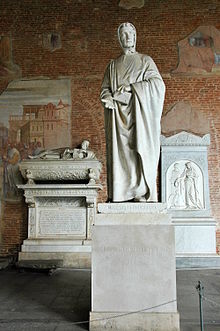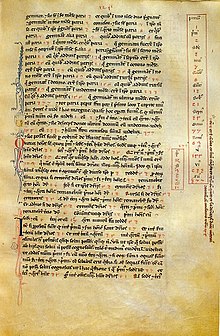Fibonacci
Fibonacci | |
|---|---|
 Statue of Fibonacci (1863) by Giovanni Paganucci in theCamposanto di Pisa[a] | |
| Born | c. 1170 |
| Died | c.1250(aged 79–80) Pisa, Republic of Pisa |
| Other names |
|
| Occupation | Mathematician |
| Known for |
|
| Parent | Guglielmo "Bonacci" (father) |
Fibonacci[b](/ˌfɪbəˈnɑːtʃi/;[4]alsoUS:/ˌfiːb-/,[5][6]Italian:[fiboˈnattʃi];c. 1170–c. 1240–50)[7]was anItalianmathematicianfrom theRepublic of Pisa,considered to be "the most talented Western mathematician of theMiddle Ages".[8]
The name he is commonly called,Fibonacci,was made up in 1838 by the Franco-Italian historianGuillaume Libri[9][10]and is short forfilius Bonacci('son of Bonacci').[11][c]However, even earlier, in 1506, a notary of the Holy Roman Empire, Perizolo mentions Leonardo as "Lionardo Fibonacci".[12]
Fibonacci popularized theIndo–Arabic numeral systemin the Western world primarily through his composition in 1202 ofLiber Abaci(Book of Calculation)[13][14]and also introduced Europe to the sequence ofFibonacci numbers,which he used as an example inLiber Abaci.[15]
Biography
Fibonacci was born around 1170 to Guglielmo, an Italian merchant and customs official.[3]Guglielmo directed a trading post inBugia (Béjaïa),in modern-day Algeria.[16]Fibonacci travelled with him as a young boy, and it was in Bugia (Algeria) where he was educated that he learned about theHindu–Arabic numeral system.[17][7]
Fibonacci travelled around theMediterraneancoast, meeting with many merchants and learning about their systems of doing arithmetic.[18]He soon realised the many advantages of the Hindu-Arabic system, which, unlike theRoman numeralsused at the time, allowed easy calculation using aplace-value system.In 1202, he completed theLiber Abaci(Book of AbacusorThe Book of Calculation),[19]which popularized Hindu–Arabic numerals in Europe.[7]
Fibonacci was a guest ofEmperor Frederick II,who enjoyed mathematics and science. A member of Frederick II's court,John of Palermo,posed several questions based on Arab mathematical works for Fibonacci to solve. In 1240, theRepublic of Pisahonored Fibonacci (referred to as Leonardo Bigollo)[20]by granting him a salary in a decree that recognized him for the services that he had given to the city as an advisor on matters of accounting and instruction to citizens.[21][22]
Fibonacci is thought to have died between 1240[23]and 1250,[24]in Pisa.
Liber Abaci

In theLiber Abaci(1202), Fibonacci introduced the so-calledmodus Indorum(method of theIndians), today known as theHindu–Arabic numeral system,[25][26]with ten digits including azeroandpositional notation.The book showed the practical use and value of this by applying the numerals to commercialbookkeeping,converting weights and measures, calculation of interest, money-changing, and other applications. The book was well-received throughout educated Europe and had a profound impact on European thought. Replacing Roman numerals, itsancient Egyptian multiplicationmethod, and using anabacusfor calculations, was an advance in making business calculations easier and faster, which assisted the growth ofbankingandaccountingin Europe.[27][28]
The original 1202 manuscript is not known to exist.[29]In a 1228 copy of the manuscript, the first section introduces the numeral system and compares it with others, such asRoman numerals,and methods to convert numbers to it. The second section explains uses in business, for example converting different currencies, and calculating profit and interest, which were important to the growing banking industry. The book also discussesirrational numbersandprime numbers.[29][27][28]
Fibonacci sequence
Liber Abaciposed and solved a problem involving the growth of a population of rabbits based on idealized assumptions. The solution, generation by generation, was a sequence of numbers later known asFibonacci numbers.Although Fibonacci'sLiber Abacicontains the earliest known description of the sequence outside of India, the sequence had been described by Indian mathematicians as early as the sixth century.[30][31][32][33]
In the Fibonacci sequence, each number is the sum of the previous two numbers. Fibonacci omitted the "0" and first "1" included today and began the sequence with 1, 2, 3,.... He carried the calculation up to the thirteenth place, the value 233, though another manuscript carries it to the next place, the value 377.[34][35]Fibonacci did not speak about thegolden ratioas the limit of the ratio of consecutive numbers in this sequence.
Legacy
In the 19th century, a statue of Fibonacci was set in Pisa. Today it is located in the western gallery of theCamposanto,historical cemetery on thePiazza dei Miracoli.[1][36]
There are many mathematicalconcepts named after Fibonaccibecause of a connection to the Fibonacci numbers. Examples include theBrahmagupta–Fibonacci identity,theFibonacci search technique,and thePisano period.Beyond mathematics, namesakes of Fibonacci include the asteroid6765 Fibonacciand the art rock bandThe Fibonaccis.
Works
- Liber Abaci(1202), a book on calculations (English translation by Laurence Sigler, 2002)[25]
- Practica Geometriae(1220), a compendium of techniques insurveying,themeasurementand partition ofareasandvolumes,and other topics in practicalgeometry(English translation by Barnabas Hughes, Springer, 2008).
- Flos(1225), solutions to problems posed by Johannes of Palermo
- Liber quadratorum( "The Book of Squares") onDiophantine equations,dedicated toEmperor Frederick II.See in particularcongruumand theBrahmagupta–Fibonacci identity.
- Di minor guisa(on commercial arithmetic; lost)
- Commentary on Book X ofEuclid's Elements(lost)
See also
Notes
References
- ^ab"Fibonacci's Statue in Pisa".Epsilones.Archivedfrom the original on 2014-02-22.Retrieved2010-08-02.
- ^Smith, David Eugene; Karpinski, Louis Charles (1911),The Hindu–Arabic Numerals,Boston and London: Ginn and Company, p. 128,archivedfrom the original on 2023-03-13,retrieved2016-03-02.
- ^abcLivio, Mario(2003) [2002].The Golden Ratio: The Story of Phi, the World's Most Astonishing Number(First trade paperback ed.). New York City:Broadway Books.pp. 92–93.ISBN0-7679-0816-3.Archivedfrom the original on 2023-03-13.Retrieved2018-12-19.
- ^"Fibonacci, Leonardo".LexicoUK English Dictionary.Oxford University Press.Archived fromthe originalon 2021-05-12.
- ^"Fibonacci series"Archived2019-06-23 at theWayback Machineand"Fibonacci sequence".Collins English Dictionary.HarperCollins.Archivedfrom the original on 12 June 2012.Retrieved23 June2019.
- ^"Fibonacci number".Merriam-Webster Dictionary.Retrieved23 June2019.
- ^abcMacTutor, R."Leonardo Pisano Fibonacci".www-history.mcs.st-and.ac.uk.Archivedfrom the original on 2019-10-28.Retrieved2018-12-22.
- ^Eves, Howard.An Introduction to the History of Mathematics.Brooks Cole, 1990:ISBN0-03-029558-0(6th ed.), p. 261.
- ^Devlin, Keith(2017).Finding Fibonacci: The Quest to Rediscover the Forgotten Mathematical Genius Who Changed the World.Princeton University Press. p. 24.
- ^Colin Pask(7 July 2015).Great Calculations: A Surprising Look Behind 50 Scientific Inquiries.Prometheus Books. p. 35.ISBN978-1-63388-029-0.Archivedfrom the original on 13 March 2023.Retrieved19 January2020.
- ^Keith Devlin,The Man of Numbers: Fibonacci's Arithmetic Revolution,A&C Black, 2012 p. 13.
- ^Drozdyuk, Andriy; Drozdyuk, Denys (2010).Fibonacci, his numbers and his rabbits.Toronto: Choven Pub. p. 18.ISBN978-0-9866300-1-9.OCLC813281753.Archivedfrom the original on 2020-02-17.Retrieved2020-01-26.
- ^"Fibonacci Numbers".halexandria.org.Archivedfrom the original on 2019-10-13.Retrieved2015-04-29.
- ^Leonardo Pisano: "Contributions to number theory"Archived2008-06-17 at theWayback Machine.Encyclopædia BritannicaOnline, 2006. p. 3. Retrieved 18 September 2006.
- ^Singh, Parmanand. "Acharya Hemachandra and the (so called) Fibonacci Numbers".Math.Ed. Siwan, 20(1):28–30, 1986.ISSN0047-6269
- ^G. Germano,New editorial perspectives in Fibonacci's Liber abaci,«Reti medievali rivista» 14, 2,pp. 157–173Archived2021-07-09 at theWayback Machine.
- ^Thomas F. Glick; Steven Livesey; Faith Wallis (2014).Medieval Science, Technology, and Medicine: An Encyclopedia.Routledge. p. 172.ISBN978-1-135-45932-1.Archivedfrom the original on 2023-03-13.Retrieved2018-12-07.
- ^In thePrologusof theLiber abaccihe said: "Having been introduced there to this art with an amazing method of teaching by means of the nine figures of the Indians, I loved the knowledge of such an art to such an extent above all other arts and so much did I devote myself to it with my intellect, that I learned with very earnest application and through the technique of contradiction anything to be studied concerning it and its various methods used in Egypt, in Syria, in Greece, in Sicily, and in Provence, places I have later visited for the purpose of commerce" (translated by G. Germano,New editorial perspectives in Fibonacci's Liber abaci,«Reti medievali rivista» 14, 2,pp. 157–173Archived2021-07-09 at theWayback Machine.
- ^The English edition of theLiber abacciwas published by L.E. Sigler,Leonardo Pisano's book of calculation,New York, Springer-Verlag, 2003
- ^See the incipit ofFlos:"Incipit flos Leonardibigollipisani... "(quoted in theMS WorddocumentSources in Recreational Mathematics: An Annotated Bibliographyby David Singmaster, 18 March 2004 – emphasis added), in English: "Here starts 'the flower' by Leonardo the wanderer of Pisa..."
The basic meanings of "bigollo" appear to be "bilingual" or "traveller". A. F. Horadam contends a connotation of "bigollo" is "absent-minded" (see first footnote of"Eight hundred years young"Archived2008-12-19 at theWayback Machine), which is also one of the connotations of the English word "wandering". The translation "the wanderer" in the quote above tries to combine the various connotations of the word "bigollo" in a single English word. - ^Keith Devlin (7 November 2002)."A man to count on".The Guardian.Archivedfrom the original on 17 September 2016.Retrieved7 June2016.
- ^«Considerantes nostre civitatis et civium honorem atque profectum, qui eis, tam per doctrinam quam per sedula obsequia discreti et sapientis viri magistri Leonardi Bigolli, in abbacandis estimationibus et rationibus civitatis eiusque officialium et aliis quoties expedit, conferuntur; ut eidem Leonardo, merito dilectionis et gratie, atque scientie sue prerogativa, in recompensationem laboris sui quem substinet in audiendis et consolidandis estimationibus et rationibus supradictis, a Comuni et camerariis publicis, de Comuni et pro Comuni, mercede sive salario suo, annis singulis, libre xx denariorum et amisceria consueta dari debeant (ipseque pisano Comuni et eius officialibus in abbacatione de cetero more solito serviat), presenti constitutione firmamus». F. Bonaini,Memoria unica sincrona di Leonardo Fibonacci, novamente scoperta,«Giornale storico degli archivi toscani» 1, 4, 1857, pp. 239–246.
- ^Koshy, Thomas (2011),Fibonacci and Lucas Numbers with Applications,John Wiley & Sons, p. 3,ISBN9781118031315,archivedfrom the original on 2023-03-13,retrieved2015-12-12.
- ^Tanton, James Stuart (2005),Encyclopédia of Mathematics,Infobase Publishing, p. 192,ISBN9780816051243,archivedfrom the original on 2023-03-13,retrieved2015-12-12.
- ^abFibonacci's Liber Abaci,translated by Sigler, Laurence E., Springer-Verlag, 2002,ISBN0-387-95419-8
- ^Grimm 1973
- ^ab"Fibonacci: The Man Behind The Math".NPR.org.Archivedfrom the original on 2011-07-16.Retrieved2015-08-29.
- ^abDevlin, Keith."The Man of Numbers: Fibonacci's Arithmetic Revolution [Excerpt]".Scientific American.Archivedfrom the original on 2014-06-18.Retrieved2015-08-29.
- ^abGordon, John Steele."The Man Behind Modern Math".Archivedfrom the original on 2015-08-23.Retrieved2015-08-28.
- ^Singh, Pamanand (1985)."The so-called fibonacci numbers in ancient and medieval India".Historia Mathematica.12(3): 229–244.doi:10.1016/0315-0860(85)90021-7.
- ^Goonatilake, Susantha (1998).Toward a Global Science.Indiana University Press. p.126.ISBN978-0-253-33388-9.
Virahanka Fibonacci.
- ^Knuth, Donald (2006).The Art of Computer Programming: Generating All Trees – History of Combinatorial Generation; Volume 4.Addison-Wesley. p. 50.ISBN978-0-321-33570-8.Archivedfrom the original on 2023-03-13.Retrieved2020-11-11.
- ^Hall, Rachel W.Math for poets and drummersArchived2012-02-12 at theWayback Machine.Math Horizons15(2008) 10–11.
- ^Sloane, N. J. A.(ed.)."Sequence A000045 (Fibonacci Numbers)".TheOn-Line Encyclopedia of Integer Sequences.OEIS Foundation.
- ^Pisanus, Leonardus; Boncompagni, Baldassarre (1 January 1857).Scritti: Il Liber Abbaci.Tip. delle Scienze Fisiche e Matematiche. p. 231.Archivedfrom the original on 13 March 2023.Retrieved20 December2018– via Google Books.
- ^Devlin, Keith (2010)."The Man of Numbers: In Search of Leonardo Fibonacci"(PDF).Mathematical Association of America.pp. 21–28.Archived(PDF)from the original on 2015-09-07.Retrieved2018-12-21.
Further reading
- Devlin, Keith (2012).The Man of Numbers: Fibonacci's Arithmetic Revolution.Walker Books.ISBN978-0802779083.
- Goetzmann, William N. and Rouwenhorst, K.Geert (2005).The Origins of Value: The Financial Innovations That Created Modern Capital Markets.Oxford University Press Inc., US,ISBN0-19-517571-9.
- Goetzmann, William N.,Fibonacci and the Financial Revolution(October 23, 2003),Yale School of ManagementInternational Center for Finance Working Paper No. 03–28
- Grimm, R. E., "The Autobiography of Leonardo Pisano",Fibonacci Quarterly,Vol. 11, No. 1, February 1973, pp. 99–104.
- Horadam, A. F. "Eight hundred years young,"The Australian Mathematics Teacher31 (1975) 123–134.
- Gavin, J., Schärlig, A., extracts ofLiber Abacionline and analyzed onBibNum[click 'à télécharger' for English analysis]
External links
- "Fibonacci, Leonardo, or Leonardo of Pisa." Complete Dictionary of Scientific Biography. 2008. Encyclopedia. (April 20, 2015).[1]
- Fibonacciat Convergence
- O'Connor, John J.;Robertson, Edmund F.,"Leonardo Pisano Fibonacci",MacTutor History of Mathematics Archive,University of St Andrews
- Fibonacci (2 vol., 1857 & 1862)Il liber abaciandPractica Geometriae– digital facsimile from theLinda Hall Library
- Fibonacci, Liber abbaciBibliotheca Augustana
